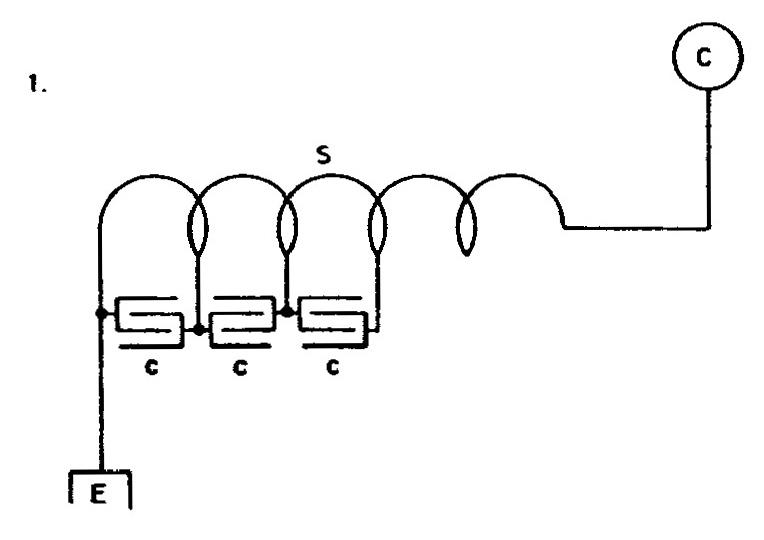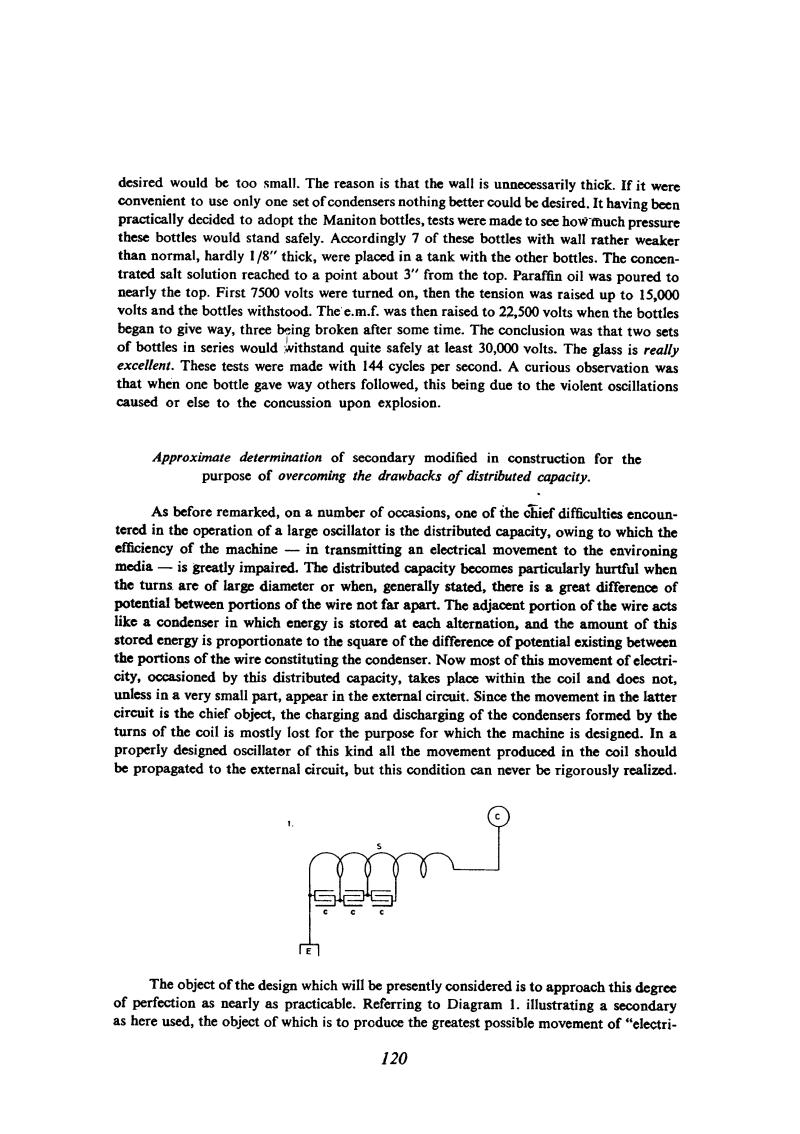
Nikola Tesla Books
desired would be too small. The reason is that the wall is unnecessarily thick. If it were convenient to use only one set of condensers nothing better could be desired. It having been practically decided to adopt the Maniton bottles, tests were made to see how much pressure these bottles would stand safely. Accordingly 7 of these bottles with wall rather weaker than normal, hardly 1/8" thick, were placed in a tank with the other bottles. The concentrated salt solution reached to a point about 3" from the top. Paraffin oil was poured to nearly the top. First 7500 volts were turned on, then the tension was raised up to 15,000 volts and the bottles withstood. The e.m.f. was then raised to 22,500 volts when the bottles began to give way, three being broken after some time. The conclusion was that two sets of bottles in series would withstand quite safely at least 30,000 volts. The glass is really excellent. These tests were made with 144 cycles per second. A curious observation was that when one bottle gave way others followed, this being due to the violent oscillations caused or else to the concussion upon explosion.
Approximate determination of secondary modified in construction for the purpose of overcoming the drawbacks of distributed capacity.
As before remarked, on a number of occasions, one of the chief difficulties encountered in the operation of a large oscillator is the distributed capacity, owing to which the efficiency of the machine - in transmitting an electrical movement to the environing media - is greatly impaired. The distributed capacity becomes particularly hurtful when the turns are of large diameter or when, generally stated, there is a great difference of potential between portions of the wire not far apart. The adjacent portion of the wire acts like a condenser in which energy is stored at each alternation, and the amount of this stored energy is proportionate to the square of the difference of potential existing between the portions of the wire constituting the condenser. Now most of this movement of electricity, occasioned by this distributed capacity, takes place within the coil and does not, unless in a very small part, appear in the external circuit. Since the movement in the latter circuit is the chief object, the charging and discharging of the condensers formed by the turns of the coil is mostly lost for the purpose for which the machine is designed. In a properly designed oscillator of this kind all the movement produced in the coil should be propagated to the external circuit, but this condition can never be rigorously realized.
The object of the design which will be presently considered is to approach this degree of perfection as nearly as practicable. Referring to Diagram 1. illustrating a secondary as here used, the object of which is to produce the greatest possible movement of âelectri
120
July 31
Tesla made the capacitors for primary circuit from mineral water bottles filled with a saturated solid salt solution. He then submerged several bottles in a metal tank filled with the same solution. By that method he obtained the capacitor groups with a common layer. Other layers (electrolyte in jars) could have been connected in parallel as desired. The least capacitance change of capacitor battery of this type amounted to exactly the capacitance of one jar. By performing the withstand tests on such capacitors at a frequency of 144 Hz he concluded that they could withstand even 30,000 volts when two series of them are connected in series. By so solving the capacitor problems in primary circuit, he returns again to the secondary circuit. In the secondary he hadn't yet solved the problem of coil distributed capacitance, in which he sees the main obstacle on the way of achievement of desirable high voltages. Tesla's analysis, somewhat strange for a reader of these days (sometimes even incorrect) as hosed on a limited number of facts, impressed with its breadth. Tesla deeply penetrates in physical processes, and attempts to understand what and how something happens. His experiments provide him with proofs for conclusions he came to on the basis of thinking and analysis of previous experiments.
By having a desire to design the secondary coil with minimal self-capacitance, and which will be able to operate at extraordinary high voltages, Tesla devoted his time, more than anybody else before him, to a study of coils. The results were not lacking (coil shapes, winding methods), but with all that Tesla was not satisfied. He thinks what would happen when he would add series capacitors, and what would happen if he could change the distance between windings, or the wire diameter, etc.


